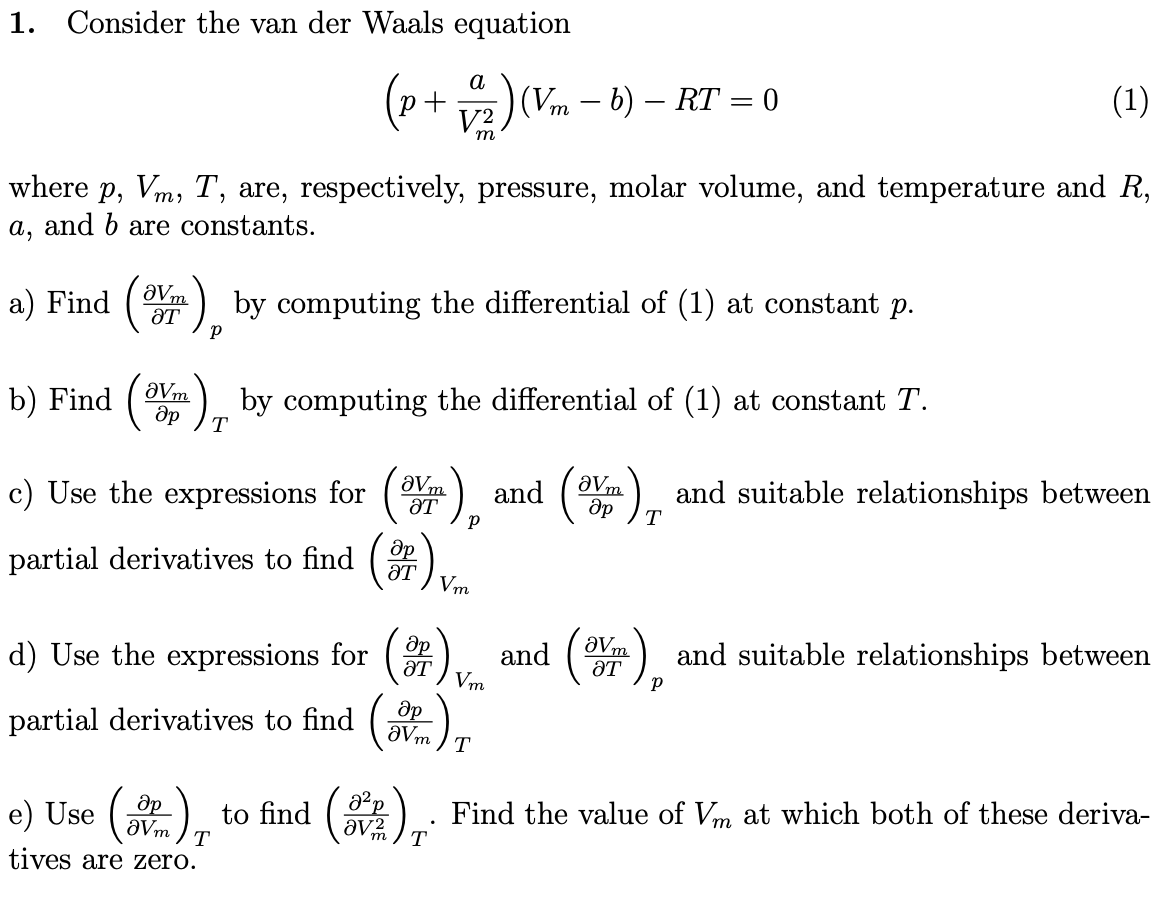Consider the van der Waals equation (1) а (p+ )(Vm – b) – RT = 0 - V2 m where p, Vm, T, are, respectively, pressure, molar volume, and temperature and R, a, and b are constants. a) Find (Vm ƏT -) by computing the differential of (1) at constant p. b) Find aVm ) by computing the differential of (1) at constant T. T and suitable relationships between T aVm c) Use the expressions for () partial derivatives to find ().. ƏVm. ƏT and ƏT Vm aVm d) Use the expressions for (). and (m) and suitable relationships between ƏT ƏT Vm partial derivatives to find ( ) av, Vm e) Use (, to find (), 2). Find the value of Vm at which both of these deriva- T ƏVm T tives are zero.
Consider the van der Waals equation (1) а (p+ )(Vm – b) – RT = 0 - V2 m where p, Vm, T, are, respectively, pressure, molar volume, and temperature and R, a, and b are constants. a) Find (Vm ƏT -) by computing the differential of (1) at constant p. b) Find aVm ) by computing the differential of (1) at constant T. T and suitable relationships between T aVm c) Use the expressions for () partial derivatives to find ().. ƏVm. ƏT and ƏT Vm aVm d) Use the expressions for (). and (m) and suitable relationships between ƏT ƏT Vm partial derivatives to find ( ) av, Vm e) Use (, to find (), 2). Find the value of Vm at which both of these deriva- T ƏVm T tives are zero.
Linear Algebra: A Modern Introduction
4th Edition
ISBN:9781285463247
Author:David Poole
Publisher:David Poole
Chapter4: Eigenvalues And Eigenvectors
Section4.6: Applications And The Perron-frobenius Theorem
Problem 69EQ: Let x=x(t) be a twice-differentiable function and consider the second order differential equation...
Related questions
Question
I need help with this problem with detailed steps.

Transcribed Image Text:1. Consider the van der Waals equation
(1)
a
(p+ v2) (Vm – b) – RT = 0
V2
m
where p, Vm, T, are, respectively, pressure, molar volume, and temperature and R,
a, and b are constants.
a) Find
aVm
) by computing the differential of (1) at constant p.
b) Find
) by computing the differential of (1) at constant T.
aVm
T
c) Use the expressions for ().
aVm
and (m) and suitable relationships between
aVm
ƏT
partial derivatives to find ().
ƏT
Vm
d) Use the expressions for ().
др
ƏT
and ().
aVm
ƏT
and suitable relationships between
Vm
partial derivatives to find ()
aVm
T
e) Use (
ap
to find (
Find the value of Vm at which both of these deriva-
av2
T
tives are zero.
Expert Solution
This question has been solved!
Explore an expertly crafted, step-by-step solution for a thorough understanding of key concepts.
This is a popular solution!
Trending now
This is a popular solution!
Step by step
Solved in 3 steps with 3 images

Recommended textbooks for you

Linear Algebra: A Modern Introduction
Algebra
ISBN:
9781285463247
Author:
David Poole
Publisher:
Cengage Learning

Linear Algebra: A Modern Introduction
Algebra
ISBN:
9781285463247
Author:
David Poole
Publisher:
Cengage Learning